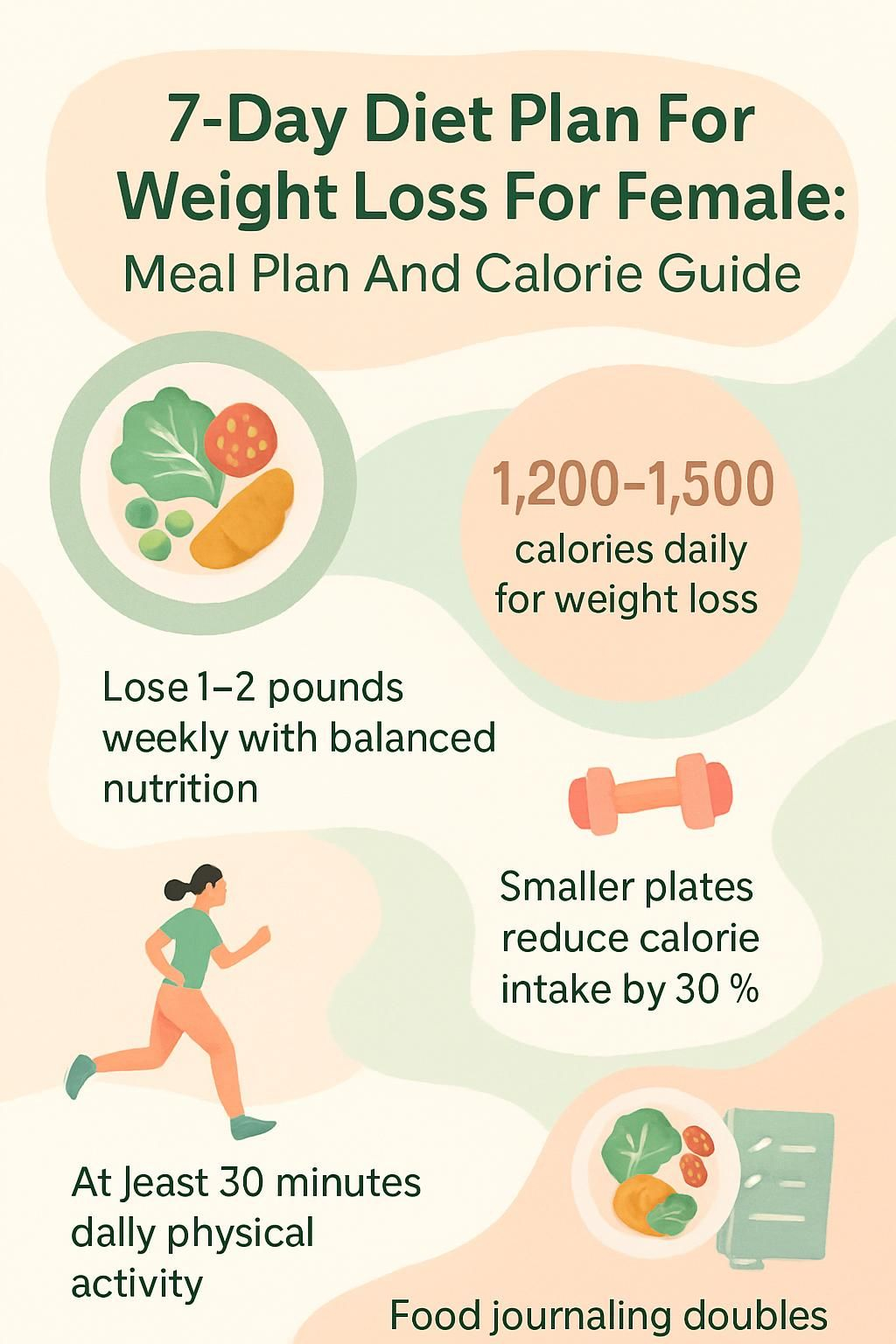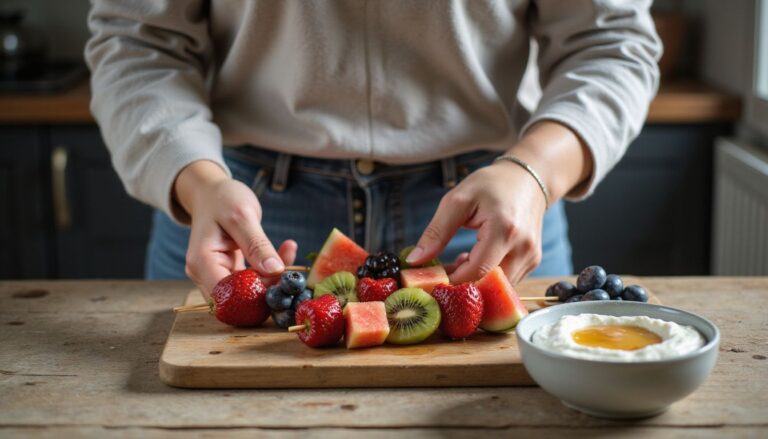7-Day Diet Plan For Weight Loss For Female: Meal Plan And Calorie Guide
Our Nutrition Assistant AI Suite will transform your body. You will lose fat, get toned, and build muscle. Gain confidence and optimal health.
Finding a simple Diet Plan For Weight Loss For Female can feel confusing. A clear 7-day meal plan helps you cut calories a day while still eating well. This guide gives you an easy meal plan, sample menus, and calorie counts so you can lose weight in a healthy way. Start today, and see how a structured eating plan makes each choice easier.
Key Takeaways
- A structured 7-day diet plan for women targets 1,200 to 1,500 calories per day. This supports a safe loss of 1 to 2 pounds per week, based on CDC guidance.
- Meals center on whole foods, including vegetables, fruit, lean protein like fish or turkey, healthy fats, and whole grains. These align with the Dietary Guidelines for Americans 2020 to 2025.
- Plan for at least 30 minutes of physical activity daily to support a calorie deficit and long-term results. Check with your clinician if you are inactive or have medical conditions.
- Portion control strategies, such as using smaller plates, can reduce intake at meals. CDC resources describe simple ways to right-size portions.
- Food journaling is linked to greater weight loss in reviews of behavior-based programs. Support from friends or groups improves follow-through.

Importance of a structured diet plan for weight loss
A structured diet plan lowers guesswork and keeps you focused on healthy weight. Following a set meal plan helps you manage calories, plan portions, and build daily routines that stick. Programs like the Mayo Clinic Diet use simple habits to reshape how you eat.
Planning meals for the week keeps your intake steady and balanced. You know what to eat at each meal, so you avoid skipped meals or last-minute fast food. That steadiness supports lower hunger and better choices.
The CDC advises aiming for a calorie deficit that leads to losing 1 to 2 pounds per week. Choosing low-calorie, nutrient-dense foods, such as vegetables, fruit, beans, yogurt, nuts, olive oil, whole grains, and lean protein, helps you meet that goal.
With an organized plan, you spend less energy deciding what to eat and more time enjoying food that supports your health.
Meal planning puts nutritious choices front and center each day.
Overview of the 7-day meal plan
You get three meals a day with one or two snacks. Each day focuses on balance and a calorie range that fits most women with light activity. Think Greek yogurt or eggs for protein, steamed broccoli or sliced tomato for vegetables, whole wheat bread or quinoa for grains, and a little olive oil or nuts for healthy fats.
Simple snacks, such as carrot sticks with hummus, keep energy steady without many calories. Planning ahead makes portion control easier and helps you hit your goals without feeling deprived.
Swaps are welcome. Use black beans instead of chickpeas, or choose low-fat milk instead of unsweetened almond milk. Flexible swaps let you personalize your plan and still meet your calorie targets, in line with the Dietary Guidelines for Americans.
Balanced nutrition and calorie control
Build a balanced plate with vegetables, fruit, lean protein, and whole grains. High-fiber foods help you feel full on fewer calories. Aim for lean proteins such as skinless chicken, fish, tofu, or beans at each meal. Most adults do well with 3 to 5 ounces of cooked protein at a time.
Include healthy fats, but keep portions modest. Nuts, avocado, and olive oil support heart health, yet they are calorie dense. For sweets, pick fruit-based treats or small servings.
Many women who want to lose weight aim for 1,200 to 1,500 calories per day. Adjust portions to match your calorie needs, and avoid very-low-calorie diets unless your dietitian or clinician recommends one. Use herbs and spices instead of heavy sauces to limit sodium and extra calories.
Understanding Weight Loss

You need a calorie deficit to lose weight. That means you burn more energy than you eat. Knowing how carbs, protein, and fats work in your body helps you build a healthy eating plan that fits your life.
The science behind weight loss
Weight loss happens when you eat fewer calories than you burn. Your body then uses stored fat for energy. Some programs start with a short, lower-calorie phase to jump-start progress, then shift to steady loss at about 1 to 2 pounds per week.
Tracking your meals and choosing nutrient-dense foods makes the process easier. Vegetables and fruit provide vitamins and minerals with few calories, which supports a calorie deficit without constant hunger.
Cutting about 500 calories per day through food, movement, or both can lead to roughly one pound of loss per week.
Next, see how a calorie deficit and a smart mix of foods team up for long-term results.
Role of caloric deficit
A caloric deficit means you take in fewer calories than you use. That gap nudges your body to burn fat stores. For many women, a 1,200-calorie plan can create that gap while still meeting basic nutrition needs when meals are planned well.
Daily movement increases the number of calories you burn. Try walking breaks, short strength sessions, or taking the stairs. During a recent week of tracking, I saw steady progress once I matched a small calorie deficit with daily walks.
A consistent deficit, paired with regular meals, supports safer loss without extreme rules or skipped meals.
Importance of macronutrients
Macronutrients are the main energy sources in food. Protein builds and repairs tissue and helps control hunger. Carbohydrates, especially those from whole grains and vegetables, provide energy and fiber. Fats support hormones and the absorption of vitamins.
Choose lean protein like fish, beans, eggs, or tofu. Fill most carbs from vegetables, fruit, and whole grains to raise fiber and support gut health. Pick healthy fats such as olive oil and nuts, and keep portions measured.
High-fiber eating patterns are linked with lower risks of heart disease, type 2 diabetes, high blood pressure, digestive issues, and obesity in large reviews of public health data. Filling half your plate with produce at most meals is a simple way to hit both macro and micronutrient goals.
Key Principles for Successful Weight Loss
These principles help you build habits that last. Think of them as guardrails that keep your meal plan for women steady through the week.
Incorporating whole foods
Choose foods close to their natural form for most meals and snacks. Vegetables, fruit, whole grains, beans, nuts, seeds, eggs, fish, and plain yogurt deliver more nutrients per calorie.
Simple ideas work best. Blend a spinach and frozen berry smoothie with low-fat milk for breakfast. Snack on hard-boiled eggs, almonds, or sliced bell peppers. Research links higher fiber from produce and beans with better hunger control and more stable blood sugar.
Keep seasoning light. Vinegar, lemon juice, herbs, and spices add flavor without extra calories.
Staying hydrated
Water aids digestion and helps control appetite. Aim for about 8 cups per day, and more if you exercise. Low-fat or fat-free milk also counts toward fluids and adds calcium and vitamin D.
Include high-water foods such as cucumbers, citrus, melon, and leafy greens. If you are active or in hot weather, carry a bottle and sip often. Hydration supports portion control and energy during your plan.
Portion control
Right-size portions keep calories in check. Use a smaller plate to make portions look larger. Fill half your plate with vegetables like broccoli, bell peppers, or leafy greens. Choose fruit as a snack instead of candy.
Use simple size guides. Your palm is a protein portion, your fist is a serving of carbs, and your thumb is a serving of oils or nut butters. Reading labels can help, since many packages hold two servings. CDC materials show that plate size and plating choices influence how much you eat.
These steps help you adjust your diet plan safely, even if you need to monitor calories for health conditions like diabetes or thyroid disorders.
The role of physical activity
Plan at least 30 minutes of activity daily to support your calorie deficit and heart health. Short walks, stair breaks, or quick home workouts all count. On day 3 or day 5, try a simple strength circuit for 10 to 15 minutes.
If you have medical concerns or are very inactive, talk with your healthcare provider first. Movement also reduces stress and can improve sleep, which supports weight control.
Next, see how the 7-day diet plan organizes your meals to make healthy eating easier.
The 7-Day Diet Plan Overview
A clear plan removes guesswork and supports steady weight loss. Think of this as your weekly map for healthy eating.
Summary of daily meal structure
Each day includes breakfast, lunch, dinner, and snacks within your calorie target. Breakfast ranges from cereal with fruit and fat-free milk to smoothies with frozen berries and a hard-boiled egg. Most options land near 250 to 300 calories.
Lunches pair whole grains or whole wheat bread with lean protein like turkey or grilled chicken. Add raw vegetables for volume and crunch. Dinners feature lean proteins such as flounder, shrimp stir-fry, baked salmon, or pork tenderloin with brown rice or quinoa and a side of greens.
This setup balances protein, produce, and whole grains to help control calories a day. Next is why variety helps you stick with your plan.
Importance of variety in meals
Variety keeps meals interesting and boosts nutrition. Rotate leafy greens, beans, whole grains, lean proteins, and healthy fats like olive oil or nuts. Mixing up produce colors also widens your vitamin and mineral intake.
Research links diverse diets with better nutrient coverage and fewer deficiencies. Try switching grains, such as brown rice one day and quinoa the next. You can also adjust meals to match a 1,300 or 1,800 calorie day by changing protein or grain portions.
Variety helps control cravings, so you are less tempted to leave your plan.
Tips for meal prep and planning
Meal prep makes your eating plan practical on busy days. It also reduces last-minute choices that can increase calories.
- Plan all meals and snacks before you shop. Aim for 1,200 to 1,500 calories daily for weight loss unless your clinician advises otherwise.
- Prep vegetables, lean proteins, and whole grains in batches. This makes quick lunches and dinners easy to build.
- Cook several portions at once. Grill enough chicken for three lunches, or cook a pot of brown rice for multiple dinners.
- Store meals in clear, labeled containers. Seeing portions helps prevent overeating and supports food safety.
- Use tracking tools or simple apps to log meals. Adjust if you need more variety or different portion sizes.
- Set one weekly prep day. Sundays work well for many people and start the week with momentum.
- Invite a friend or family member to help. Social support improves follow-through in many studies.
- Keep water nearby while prepping. Staying hydrated may curb grazing while you cook.
These steps keep your 7-day plan consistent and support steady weight loss.
Sample Meal Plans for 7 Days
This sample diet meal plan balances calories and nutrients. Use it as a template, then personalize for taste and needs.
Detailed breakdown of daily meals
A 7-day diet plan gives you a clear structure. Focus on protein, vegetables, fruit, and whole grains to manage calories without feeling deprived.
- Start most days with a balanced breakfast like 1 cup Cheerios with a small banana and fat-free milk, or Greek yogurt with fresh berries.
- Day 3 breakfast example: half cup oats soaked in low-fat or unsweetened soy milk, half chopped apple, one teaspoon honey, cinnamon to taste.
- For lunch, pair lean protein such as turkey breast or roast beef with whole-grain bread. Add raw vegetables for fiber and volume.
- Day 3 lunch example: chicken salad with 4 ounces cooked chicken, quarter cup grapes, 1 tablespoon almonds, quarter cup celery, 1 tablespoon mayonnaise, and 1 tablespoon Greek yogurt. Serve over lettuce with one slice multigrain toast.
- Choose dinners built around lean protein. Flounder works with couscous and steamed vegetables. Salmon pairs well with brown rice and asparagus.
- Day 3 dinner example: 4 ounces steamed shrimp, one baked potato topped with 3 tablespoons salsa and 1 tablespoon Greek yogurt, plus 3 cups steamed spinach. Add a small treat such as 1 ounce chocolate or a 100 to 150 calorie ice cream bar.
- Day 5 dinner example: pork tenderloin with a light balsamic and herb glaze and roasted butternut squash, about 370 calories.
- Use fruit for snacks or dessert to curb cravings without breaking your calorie budget.
- Adjust portions to fit your goals. Use measuring cups or a kitchen scale for accuracy.
- Rotate proteins, such as shrimp, salmon, chicken breast, tofu, or pork tenderloin, to keep flavor fresh and nutrition balanced.
Suggestions for modifications based on dietary preferences
Customize this 7-day plan to fit your taste, health needs, and culture. Small swaps keep meals enjoyable while meeting your calorie target.
- Swap proteins as needed. Use tofu for chicken or beans for fish based on taste, allergies, or vegetarian choices.
- Double vegetables for extra fiber and fullness with minimal calories.
- Pick whole-grain options, such as quinoa instead of white rice or whole wheat pasta instead of regular pasta.
- Add fruit between meals if hunger rises before dinner. Berries, apples, and oranges work well.
- Adjust portion sizes with measuring tools so your intake matches your number of calories for the day.
- Choose dairy alternatives like almond milk or soy yogurt if you avoid lactose or follow a vegan eating style.
- Use salt-free seasoning blends to raise flavor without sugar or extra sodium.
- Include a protein source at every meal, such as eggs, fish, legumes, nuts, or lean meats.
- Cook extra servings during prep so healthy options are ready on busy days.
- Pull ideas from plans for different ages or family members to build menus that everyone can enjoy.
I once switched my lunch protein from grilled chicken to black beans and felt fuller longer. That small change made sticking to the plan easier.
Calorie Guide for Each Meal
Knowing the calories in each meal helps you match intake to your goals. Use this guide to adjust portions, especially on active days.
Breakdown of calorie count for each meal and snack
This table shows a sample 1,200-calorie, Mediterranean-style day with a few featured dinners and snacks. Use it as a starting point and adjust based on your activity level and preferences.
| Day | Meal | Menu Example | Calorie Count |
|---|---|---|---|
| 1 | Breakfast | Oatmeal with berries | 220 |
| 1 | Lunch | Grilled chicken salad | 300 |
| 1 | Dinner | Salmon with roasted vegetables | 340 |
| 1 | Snack | Greek yogurt with fruit | 140 |
| 1 | Sweet | Dark chocolate, 0.5 oz | 75 |
| 2 | Dinner | Barbecue cutlets, 2 cups sautéed spinach, 1/2 baked potato | 265 |
| 3 | Dessert | 1 oz chocolate or 100 to 150 calorie ice cream bar | 100-150 |
| 5 | Dinner | Pork tenderloin with glaze | 370 |
| Daily | Snacks | Nuts or sliced vegetables | 100 |
| Daily | Sweet | 75-calorie dessert portion | 75 |
Modify portions to fit your personal calorie target, especially if you are very active or prefer larger meals earlier in the day. Keep an eye on sauces and dressings since they can add calories fast.
Tips on portion control based on individual caloric needs
Set a daily calorie goal that matches your activity and height. Many moderately active women lose weight on 1,200 to 1,800 calories per day.
Measure portions with a scale or cups until your eyes adjust. Load up on low-calorie vegetables like spinach, broccoli, and peppers to add volume. Swap larger plates for smaller ones to help control portions visually.
Track food in a diary or app to spot patterns and make small fixes. If you have chronic conditions like diabetes or thyroid issues, check with your healthcare provider before starting a reduced-calorie plan.
Tips for Staying on Track
Strong habits make your plan easier to follow. Think preparation, tracking, and support.
Meal prep strategies
Pick a few go-to recipes and prepare them on a set day each week. Use reusable containers to portion meals such as overnight oats for breakfast and grilled chicken salads for lunch. Batch-cook brown rice, roasted vegetables, and lean proteins to save time.
Keep a simple log of what you prep so you stay aware of calories and nutrients. Try new ideas like vegetable frittatas or chickpea wraps to keep interest high. Making extra servings has helped me avoid random snacking on busy days.
Keeping a food diary
Meal prep sets the stage; logging helps you follow through. A food diary shows what and how much you eat. Many reviews link self-monitoring with better weight loss outcomes.
Use a notebook or an app. Log ingredients, times, calories, and even emotions when helpful. A 2015 review in Obesity Reviews found that consistent tracking was associated with greater success.
Seven days of honest logging can reveal trends and quick wins for your diet plan.
The importance of support systems
Support improves results. People who involve friends, family, or groups often lose more weight than those who go solo. Share goals, swap recipes, and check in weekly.
If you have medical needs, consult a clinician or dietitian before you start. During my own plan, texting a friend after dinner kept me accountable and motivated for a daily walk.
Summary: Strong support raises your chances of reaching your weight loss goals and staying there.
Maintaining Weight Loss After the 7-Day Plan
You can keep your results by building healthy routines you can live with. Think steady steps, not quick fixes.
Transitioning to a sustainable diet
Keep foods you enjoy in your plan. Lean proteins, whole grains, and plenty of fruits and vegetables help control calories while covering nutrients. Plant-forward eating patterns lower long-term disease risk in many studies.
After the first week, add changes gradually. Try a new seasonal vegetable each week or rotate breakfast ideas. Tracking helped me spot easy swaps that kept meals satisfying without adding many calories.
Regular movement supports your metabolism as you settle into a routine that lasts.
Importance of ongoing physical activity
Plan at least 30 minutes of daily activity to maintain your progress. Brisk walking, cycling, or group classes add structure. Simple choices like taking stairs or parking farther away raise your total movement.
Regular activity supports heart health, mental well-being, and weight control. A short walk after meals helped me manage cravings and stay energized during packed weeks.
More daily movement also gives you a little more room in your calorie budget.
Setting long-term health goals
Clear goals keep you focused past week one. Set targets that are specific and realistic, such as losing 2 to 4 pounds per month. Use a journal or app to track actions, such as cooking at home five days a week or reaching 7,000 steps daily.
Break big goals into small steps, then build from there. Non-scale wins count too, including better sleep, more energy, or cooking skills that make healthy eating easier.
Small, steady actions lead to lasting change you can maintain.
Common Pitfalls to Avoid
Knowing the common traps helps you sidestep them. A little planning goes a long way.
Emotional eating
Stress, boredom, or sadness can trigger eating when you are not hungry. Many adults report eating more during stressful times. Sugary or fatty snacks may bring quick comfort, but they can raise calorie intake fast.
Identify your triggers. Use a food diary to note your feelings before you eat. Try deep breathing, a short walk, or calling a friend. Building these skills reduces the urge to use food to handle emotions.
Awareness is the first step to long-term success with weight management.
Skipping meals
Skipping meals often backfires. It can slow your metabolism and trigger late-day cravings. You may then overeat at night.
Your plan includes three structured meals to keep you satisfied and focused. Spacing meals helped me stay alert during work and avoid vending machine snacks. Regular meals support steady energy and better portion control.
Over-restriction vs. balance
Extreme rules, such as cutting entire food groups, tend to fail. Studies show strict restrictions raise cravings and can lead to giving up. A flexible plan with plenty of vegetables and fruit helps prevent a sense of deprivation.
Balanced choices beat rigid rules. I once removed bread completely, then lost motivation fast. Allowing small portions made my routine easier to follow.
Balance supports sustainability, which is key for long-term weight loss.
Conclusion
You have the tools to start a simple 7-day weight loss meal plan. Keep your focus on balance, portions, and daily movement. If you have health conditions or take medications, talk with a clinician or registered dietitian before starting.
Recap of the benefits of the 7-day diet plan
A 7-day diet plan gives structure, clear portions, and balanced nutrition. You build a calorie deficit safely, often leading to 1 to 2 pounds lost per week. The plan centers on whole foods, so you support heart health and blood sugar while you lose weight.
Daily planning and basic tracking increase follow-through. Many readers find they feel more in control after just one week.
Encouragement to personalize the plan for individual needs
Set your calorie target between 1,200 and 1,800 based on activity. Use unlimited vegetables and plenty of fruit to add volume without many calories. Swap proteins or grains to fit taste or allergies and still keep a balanced diet.
Mix textures and flavors to stay motivated across day 1 to day 7. Small, personal tweaks keep your plan enjoyable and easier to maintain.
Call to action for readers to start their journey towards healthier living
Talk with your healthcare provider to make sure this eating plan fits your needs. Then pick a start date, plan your grocery list, and schedule one prep day. Track your meals for a week and adjust portion sizes as needed.
Use trusted sources like CDC nutrition pages or the Dietary Guidelines for Americans for extra guidance. Today is a good day to begin a simple 7-day meal plan that supports your healthy weight.
FAQs
1. What is the main goal of a 7-day diet plan for weight loss for women?
A 7-day meal plan aims to help females reduce body fat by controlling calorie intake and promoting balanced nutrition. Research shows that structured eating plans can support steady, healthy weight reduction when combined with regular activity.
2. How many calories should most women eat daily on this type of meal plan?
Most adult females seeking gradual weight loss benefit from consuming between 1,200 and 1,500 calories per day. This range supports energy needs while creating a calorie deficit needed for fat loss. A registered dietitian or healthcare provider can personalize these numbers based on age, height, current weight, and activity level.
3. What foods are included in a typical weekly menu for this guide?
A sample week includes lean proteins such as poultry or fish; whole grains like brown rice or oats; fruits including berries or apples; vegetables such as spinach or broccoli; low-fat dairy products; nuts and seeds in moderation. These choices offer essential vitamins and minerals while supporting satiety.
4. Can I follow this meal plan if I have dietary restrictions?
Yes, you can adjust the menu to fit vegetarian diets or food allergies by swapping protein sources or choosing gluten-free grains where needed. Consulting with a nutrition expert ensures your modified plan meets all nutrient requirements without exceeding recommended calorie limits.
Summary:
This evidence-based guide provides clear answers about safe calorie targets, suitable foods, customization options for special diets, and the overall purpose behind structured seven-day eating plans designed specifically for female weight management goals.







